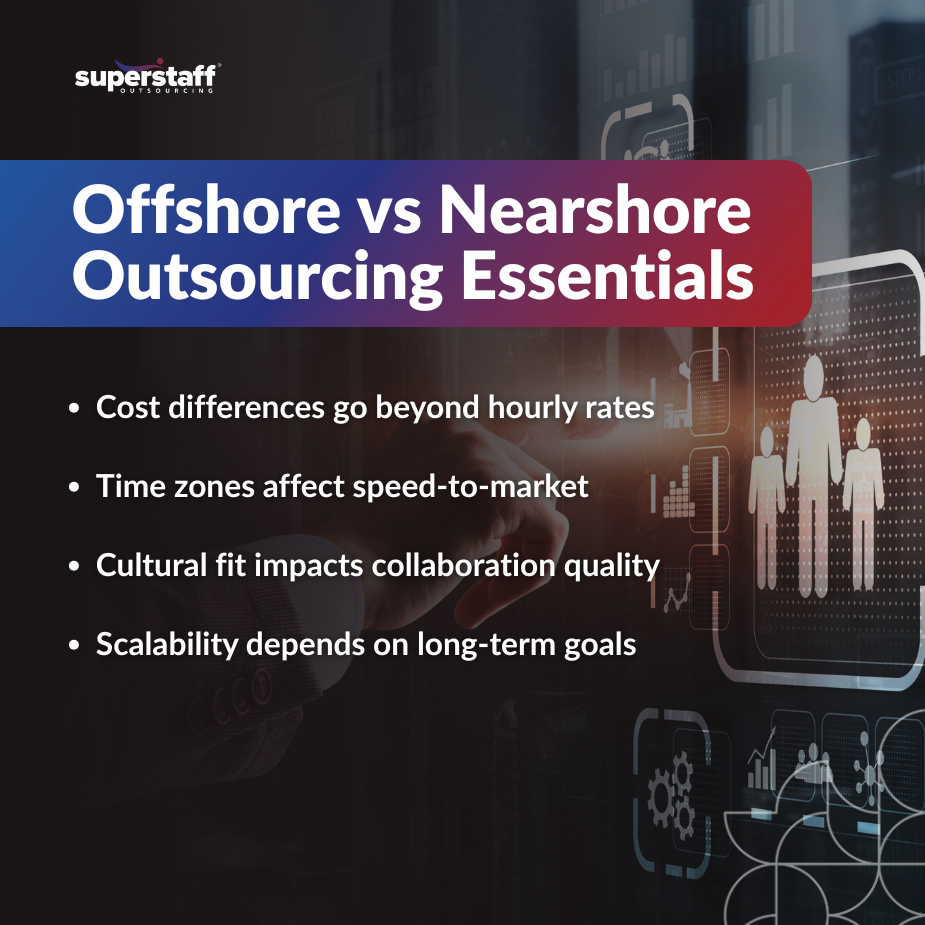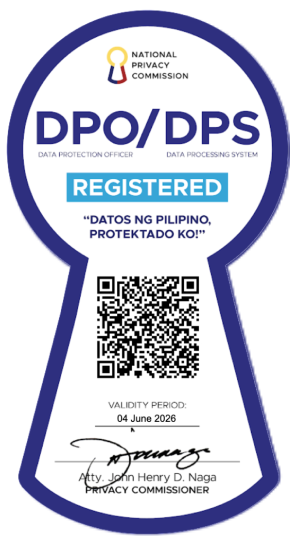
Every CEO, COO, and operations leader eventually faces it — the choice between nearshore and offshore teams. In boardrooms and strategy sessions, the offshore vs nearshore outsourcing question can be as consequential as selecting a new market or launching a flagship product. It is not just a matter of cutting costs; it is about shaping how your company operates, innovates, and competes. In 2025, with global markets more interconnected yet volatile, deciding between these two models can set the trajectory for both short-term wins and long-term stability.
Nearshore outsourcing refers to partnering with service providers in countries geographically close to your headquarters, often with similar time zones and overlapping work hours. Offshore outsourcing means working with teams much farther away, often in countries with significantly different time zones but deeper cost advantages. Both have proven track records, but neither is a one-size-fits-all solution. The real challenge is knowing which one matches your operational DNA. This guide will give you a clear framework for knowing when to go nearshore and when to go offshore — all grounded in practical insights that senior leaders can act on immediately.
Understanding the Difference Between Nearshore and Offshore Outsourcing

Before a business can make the right call, leaders need clarity on what each model entails. The nearshore model is defined by its close geographic proximity, which usually means shared or partially overlapping time zones. This overlap allows for smoother real-time collaboration, faster feedback cycles, and cultural similarities that reduce friction in communication. Countries like Mexico, Colombia, and Costa Rica often serve U.S. companies as nearshore partners because they combine a skilled talent pool with operational familiarity.
On the other hand, the offshore model spans continents and time zones. Companies in the United States may offshore work to the Philippines, India, or Vietnam, gaining access to larger labor pools and more competitive rates. Offshore teams can operate while your in-house teams rest, enabling a 24/7 productivity cycle if managed well. However, differences in culture, time zones, and regulatory environments require deliberate coordination. Understanding this foundational divide is critical before weighing the deeper pros and cons in the offshore vs nearshore outsourcing decision.
Cost Efficiency Beyond the Obvious
For many executives, the conversation starts — and often ends — with cost savings. Offshore outsourcing is generally associated with lower hourly rates and reduced overhead. Labor costs in offshore hubs can be significantly less than those in nearshore destinations, creating immediate budget relief for cost-sensitive projects.
Nearshore solutions, while not as low-cost on paper, can present savings in other ways. Reduced travel times, more affordable flights for leadership visits, and fewer communication delays can improve overall efficiency and lower the “hidden costs” of managing the relationship. For example, a marketing firm with high collaboration needs might find that paying a slightly higher hourly rate for a nearshore partner ultimately saves money by preventing miscommunications and rework.
The key takeaway is that leaders should look beyond the sticker price. True cost efficiency comes from aligning the outsourcing model with the project’s complexity, the need for collaboration, and the acceptable tolerance for turnaround times. Over the life of a contract, these factors can shift the balance in the offshore vs nearshore outsourcing equation.
Operational Efficiency and Speed-to-Market
In competitive industries, the difference between launching a product in six weeks instead of eight can determine market share. Nearshore outsourcing excels in situations where tight coordination, same-day communication, and rapid adjustments are essential. With minimal time zone differences, your teams can troubleshoot in real time, brainstorm in live meetings, and adapt without waiting for overnight responses.
Offshore outsourcing offers a different kind of operational edge. While real-time collaboration may be limited, the ability to hand off work at the end of the day and wake up to completed tasks is a powerful advantage for companies with well-structured asynchronous workflows. Software development sprints, customer support queues, and data processing can continue non-stop, allowing businesses to achieve round-the-clock momentum.
The decision between the two models often comes down to whether your operational culture thrives on simultaneous interaction or can fully leverage the relay-race dynamic of global time differences. This operational fit is central to getting the offshore vs nearshore outsourcing choice right.
Cultural Compatibility and Language Alignment
The human element of outsourcing is often underestimated until it becomes a pain point. Cultural alignment influences how teams interpret instructions, manage conflict, and approach deadlines. Nearshore partners often share cultural and business norms with their clients, making them easier to integrate into customer-facing or collaborative roles. For North American companies, Latin American partners often bring strong English proficiency, a familiarity with Western business etiquette, and even similar holiday schedules.
Offshore partners in established outsourcing hubs like the Philippines or India bring their own strengths. These regions have decades of experience working with global companies, and their professionals are trained to adapt to diverse cultural expectations. In some cases, offshore partners offer specialized language capabilities for multilingual customer service, making them invaluable for businesses expanding into new markets.
Language proficiency and cultural fluency are not “soft” factors. They directly affect customer satisfaction, employee morale, and the long-term sustainability of your outsourcing relationship. In many cases, these nuances can outweigh minor cost differences in the offshore vs nearshore outsourcing debate.
Industry-Specific Alignment
Some industries naturally lean toward one model over the other. Businesses that rely on constant collaboration — such as creative agencies, product design teams, or agile software development shops — often prefer nearshore arrangements for their ease of real-time coordination.
On the flip side, industries with large-scale, process-driven needs frequently see offshore outsourcing as the more strategic fit. Customer service operations, technical support, back-office processing, and data entry are areas where offshore teams can scale rapidly without compromising quality. Established offshore markets also have specialized training ecosystems that can ramp up hundreds of skilled workers for these high-volume functions.
Matching your industry’s rhythm and requirements to the right model can make the offshore vs nearshore outsourcing decision far more straightforward.
Scalability and Long-Term Goals
Outsourcing is rarely a short-term solution. For many companies, the initial pilot project is just the start of a multi-year relationship. Nearshore partners can support regional growth, especially for businesses looking to expand into neighboring markets. Their physical and cultural proximity can smooth the path for cross-border partnerships, localized marketing, and regulatory navigation.
Offshore partners, meanwhile, excel in scaling large teams quickly. Businesses entering aggressive growth phases can benefit from offshore hubs’ ability to ramp up staffing in weeks rather than months. These markets often have deeper talent pools for specialized skills, from advanced IT support to complex financial services, making them ideal for global expansion strategies.
When long-term goals are the lens, the offshore vs nearshore outsourcing choice should align with where you see your company in five to ten years, not just the immediate project horizon.
A Decision Framework for Leaders
While there is no single formula that works for every company, leaders can weigh cost, time zone alignment, cultural compatibility, and talent specialization to guide the decision. Nearshore options might score higher for collaboration-intensive projects, while offshore choices may dominate on scale and cost.
For example, if your priority is cutting time-to-market while maintaining close coordination, nearshore will likely emerge as the stronger candidate. If you need to maximize budget efficiency for a large-scale operation, offshore will often deliver greater returns. Thinking in these trade-offs helps create a clear internal alignment before approaching potential vendors and is key to navigating when to choose nearshore vs offshore outsourcing successfully.
Real-World Scenarios
Consider a midmarket SaaS company that struggled with late-night bug fixes because its developers were several time zones away. Transitioning part of its team to a nearshore location allowed them to collaborate during normal working hours, dramatically improving release timelines.
In another scenario, a retail brand managing a surge in customer inquiries during holiday seasons partnered with an offshore call center in the Philippines. The move allowed them to handle triple the volume without a proportional increase in costs. Both companies made the right choice for their circumstances — and both benefited from aligning their outsourcing model with their operational realities.
These examples show how the offshore vs nearshore outsourcing choice can either accelerate success or slow it down, depending on how well it fits your organization’s needs.
Making the Transition Work
Choosing a model is only half the journey. Implementation determines whether you realize the potential of your decision. This starts with onboarding that familiarizes outsourced teams with your culture, workflows, and brand voice. Training should be tailored not just to technical tasks but also to communication styles and expectations.
Clear KPIs and service-level agreements ensure accountability, while regular check-ins and feedback loops keep both sides aligned. Whether you go nearshore or offshore, the companies that see the best results are the ones that treat their partners as extensions of their own team rather than separate entities. In the end, execution discipline is the equalizer in the offshore vs nearshore outsourcing conversation.
Choosing the Right Path in the Offshore vs Nearshore Outsourcing Debate
The offshore vs nearshore outsourcing decision is not about finding a universal “best” option. It is about finding the model that aligns most closely with your company’s goals, industry demands, and operational culture. Cost savings, efficiency, cultural fit, industry compatibility, and scalability all play decisive roles.
SuperStaff helps businesses navigate this choice with tailored assessments that consider your specific needs and long-term strategy. Whether you are exploring the agility of nearshore operations or the scale of offshore teams, our experts will help you build a partnership that delivers measurable results. Contact us today to start a conversation about the outsourcing model that will take your business where it needs to go.






